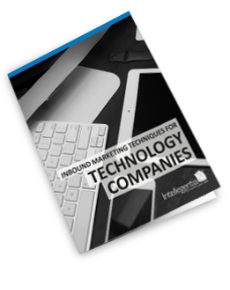
Does your marketing strategy continually adapt to changing customer behaviour, technological advancements and industry trends? Or do you rely on the same methods year after year to bring in business and engage visitors?
Marketing constantly adjusts and reacts to changes in technology and attitudes and so your strategy must do the same. 15 years ago, if you mentioned the words “social media strategy” to any marketing department you would be viewed with suspicion, but now it is a crucial part of any marketing campaign. The technology involved in inbound marketing and the way consumers make purchasing decisions has changed at a faster rate than many companies are able to keep up with. In order to stay ahead of the competition and meet the needs of your buyers it is important to be aware of the latest and upcoming marketing trends.
If, like most successful organisations, you are already strategising your marketing for 2016, you will already be aware of many of the upcoming inbound marketing trends that are already beginning to change the way marketers work. Marketing strategies that generated leads this time last year may be doing no more than gathering dust by the time January arrives. You will need to look beyond the usual channels to stay ahead of the game rather than sticking to the same old outdated methods.
In this article, we’ll look at those trends that are changing the face of marketing yet again and give you an eye-opening look at the mistakes you will have to avoid in 2016.
1. Video is the future
Video is here already and is growing rapidly. It is estimated that by 2017 video will account for 69% of all consumer Internet traffic (Cisco). Trends show that users are becoming more receptive to video online and moving away from long form content, with over 70% of marketers claiming that video has a better impact on conversions than any other content. (Demand Metric)
Marketers who are not already using video would be wise to insert it into their content marketing strategy if they want to keep ahead of the competition and keep prospects and customers engaged. If you do not have the budget for a top of the range video camera, editing software and A-list actors, this is not a problem. We are seeing a huge rise in user-generated content and lower production costs. With camera technology improving in smartphones and tablets (the latest iPhone has a 12-megapixel camera), we can all be professional photographers without having to splash out on expensive kit.
But what you do need is a team who can create great content, and compile it in a meaningful way to tell your brand’s story with impact.
2. Data Protection Changes
One of the major changes that all marketers need to be aware of is the changes to data protection regulations, which are set to come into effect next year and will have a huge impact on the world of B2B marketing. Details of the data protection changes in 2016 are due to be finalised in Spring next year, but many marketers are already feeling concerned about how this could affect their work.
Some of the key changes that are being discussed include:
- Aligning all countries with the same interpretation of the EU data protection laws. This may mean that all countries operate permission-based marketing for B2B as well as B2C. Currently in the UK we can purchase lists of B2B contacts and market to them in the context of their business. That may be outlawed in 2016 if laws are passed to bring B2B marketing in line with B2C whereby explicit permission is needed.
- All businesses handling EU residents’ data will need to delete personal information on request or when it is no longer required by the organisation – “the right to be forgotten.”
For many marketers this will require a complete overhaul of the way you engage prospects and maintain prospect data. But this doesn’t have to be an obstacle, it can be an opportunity for growth. The data protection changes don’t mean that you can’t attract new prospects, you will just have to attract them in a different way.
Using inbound marketing methods, you can attract prospects in a way that encourages them to exchange their contact details for relevant, valued information. The end result is higher quality prospects for a lower cost.
3. Marketing will shift to mobile devices
From smartphones and tablets to wearable gadgets like the Apple Watch, the evolution of mobile devices is one of the chief factors influencing the marketing world. As the focus shifts to smaller screens, brands will be able to strike up a more personalised relationship with their customers by leveraging the power of mobile in their marketing strategies.
As smartphone adoption continues to rise with an estimated 2 billion consumers worldwide expected to own a smartphone by 2016, the opportunity for brands to connect with their customers and prospects is closer than ever.
Responsive design, embedded videos, and other mobile elements will become common practice and expected by consumers, so ensure your development team has set up your business for mobile success.
4. Data-driven marketing
The customer journey is constantly evolving – the buying process is vastly different since the advent of mobile technology and the increasingly vast expanse of information that is now right at the buyer’s fingertips. Buyers are more and more informed before they make their purchases. In fact 60% of the B2B buying process is already complete before a buyer even makes contact with a sales person.
Buyers know what they want, and it is up to you to show them you can provide it. This means engaging your prospects by giving them the content, the information and the high-quality service they are looking for.
Focus on building stronger loyalty and long-term customer engagement rather than on quick, short-term customer acquisition and individual sales. This helps companies develop strong, emotional connections to their brands that drive word-of-mouth promotions and lead generation, not to mention customer retention.
The key to how you can personalise your outreach is data-driven marketing. We now have access to a much vaster range of data about our clients than ever before, through which we can develop strong relationship-marketing. In 2016 and beyond, personalised, data-driven marketing will become essential.
Intrusive, mass-target approaches to marketing will slowly dwindle as marketers who focus on relationships take centre stage.
5. Short form content
Today’s buyers are busier and more time-constrained than ever. They want to find information and consume it as quickly as possible. As a result we are seeing a growth in short form content and ephemeral marketing. Long form content can be great when used appropriately, but when looking to solve their business challenges, buyers want to be able to absorb the relevant information as quickly as possible. Twitter paved the way for this trend in restricting posts to only 140 characters and since then we have seen marketing platforms such as Vine (on which allows users post looping 7 second videos) and Snapchat, on which content has an expiration date.
Although these particular platforms may not be relevant to your specific audience, the theme is the same. Users of social media are increasingly looking to digest information in real time, and as quickly as possible.
Exclusive and time-restricted content allows your prospects to feel more connected to your brand. The “less is more,” style of marketing where communication is shorter and more to the point is very effective in a world where people have less and less time on their hands.
These 5 tips should give you an idea of the trends you can expect to take off in the next year and the traps marketers may fall into that you are now equipped to avoid. These game-changing trends should hopefully be essential elements in your 2016 marketing plans.
What have we missed? Let us know!
What next?
We've made sporadic mention of Inbound Marketing techniques in this blog, so why not take a look at that in more detail? We created this eBook for technology companies, but Inbound Marketing is equally appropriate for many other B2B marketers.
To find out how implementing Inbound Marketing techniques today could help you achieve the business goals you're setting for 2016: download our eBook Inbound Marketing Techniques for Technology Companies.
.png?width=250&height=76&name=Intellegentia%20Logo%20(MAIN).png)
